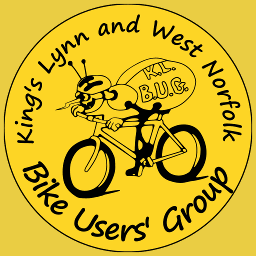If you have time today, please respond to the King's Lynn Transport Strategy consultation. In case it helps, here are my answers:
- Yes (you don't have a choice!)
- King's Lynn and then some factual questions (pick the closest answer if you fall in one of the gaps due to poor wording)
- Enter your postcode (contrary to the explanation, it requires either nothing or the full code, but you can put 0AA or 1AA as the ending.)
- Strongly agree with the overall vision.
- Agree (I'd prefer some mention of it being sustainable and healthy housing and development)
- Strongly agree
- Strongly agree
- Strongly agree
- Strongly agree
- Agree (I'd prefer the term "Reduce road danger" or some commitment to reduce casualty rates, as many negative victim-blaming policies have been promoted under the disgraced old "road safety" term.)
- Strongly agree (but it's up to you).
- Agree (this is weaker than I'd like)
- Disagree (I want improved strategic connections, but building a moat of bigger roads around the town is not strategic connectivity.)
- Strongly disagree (I disagree with the suggestion that transport and health should be "balanced" with some unspecified needs, which looks suspiciously like the needs of outsiders to pollute town homes.)
- Agree (I'd prefer them to use the Bus Act to franchise and operate a network, but this isn't awful.)
- Strongly agree
- Strongly agree (even if I wish they would just get on with doing it when possible and not only work with partners)
- Strongly agree (because what's the alternative? Keep on polluting and let severe weather become ever more disruptive?)
- Strongly agree
- Strongly agree (the road safety point should have been more like this)
- Strongly agree
- LCWIP 1, STARS Gyratory Plus 2, Micromobility 3
- LCWIP 1 because this includes a whole network and some of the other projects, STARS Gyratory Plus 2 because Railway Road cuts the town centre in two at the moment and is one of the biggest single obstacles for the LCWIP to overcome, and Micromobility 3 to make it easier for visitors to move around and fill in the gaps in the bus network.
- Yes. Take the tough decisions on:
- where cars will park which will drive a circulation plan to get them there with the least interference with other modes;
- which routes will become bus trunks with buses getting signal priority and other measures encouraging services on that route while discouraging through motor traffic: Hardings Way / Wisbech Road and Gayton Road past the QEH both seem likely candidates;
- which greenways will be brought forwards first and how they will connect to the LCWIP network;
then use this to inform the transport strategy and produce something with a simpler story behind which evidence-led projects are prioritised. Building a moat of bigger roads around the town seems a very expensive folly that is very unlikely to deliver the strategy's vision.
- Up to you.
- (left blank)
- The SEA Framework presented here minimises several of the key objectives. For example, active travel goes from being an objective on its own to being a small part of SEA objective SEA2. These are serious changes in the weighting of the objectives that invalidate the assessment. The Framework should be redrafted to align more closely with the strategy objectives and give them equal weight. In Table 5, there seem obvious possible alternatives for policies 1 (acting alone when possible as well as in partnership) and 4 (greater involvement in bus services, including franchising and operating) which have not been considered. In Table 8, the demographics of users also should be monitored to assess inclusivity; the length per capita of green infrastructure should be monitored; and the decreases and reductions in collisions and casualties should be per user and/or per km by type and not merely absolute numbers.
and for the rest, answer as you like! Thank you!
